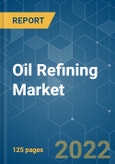The oil refining market is expected to record a CAGR of slightly more than 1.5% during the forecast period. The COVID-19 outbreak in Q1 2020 had a moderate negative impact on the oil refining market due to a reduction in the consumption of oil refined products. For instance, countries like India consumed 37.19 billion liters of petrol in 2020, from 42.27 billion liters in 2019. Further, the COVID-19 pandemic has caused delays in several refinery up-gradation projects. Growth in refining capacity in major regions, such as in Asia-Pacific, is expected to drive the demand for petroleum products in the coming years. However, the oil refining market is restrained by a lack of investments in the oil and gas sector, delayed commissioning projects, acquisition of lands, and increasing adoption of electric vehicles in developed and developing countries worldwide.
Key Highlights
- The expansion of downstream infrastructure worldwide, in order to meet the increasing demand for refined petroleum products, is expected to drive the market during the forecast period.
- Some of the major African countries, such as Nigeria and Algeria, are planning to convert themselves into regional hubs for refineries in the coming years. This factor, in turn, is expected to create huge opportunities for the international and domestic refiners to tap into the African market in the future.
- Asia-Pacific is expected to remain the major player in the oil refining market. As of 2021, the region covered around 26.3% of the global refining capacity. It is expected to remain the major region during the forecast period, owing to the upcoming major refinery projects in China and India.
Key Market Trends
Expansion in the Downstream Infrastructure
- The demand for oil as fuel in the transportation sector is likely to maintain its momentum in the short term. The recovery in oil consumption trends, driven by lower oil prices, is expected to support this momentum. Many countries across the world are trying to invest in refining capacity to reduce their dependence on imported refined petroleum products.
- Several petrochemical projects are planned to be constructed across the world. For e.g., 512 petrochemical projects are expected to commence operations in China during 2021-2025. According to a petrochemicals report published by the International Energy Agency (IEA), nearly all regions except for Europe will increase the production of primary chemicals by 2050. However, the largest capacity growth is seen in the Middle East and Asia-Pacific
- In addition, in Abu-Dhabi, Reliance Industries (RIL) and Abu Dhabi National Oil Company (ADNOC) signed an agreement in 2021 to set up a new petrochemical complex in Ruwais, Abu Dhabi. The integrated plant will have a capacity to produce 940,000 ton of chlor-alkali, 1.1 million ton of ethylene dichloride, and 360,000 ton of PVC annually.
- The United States has about 95 planned and announced projects, which are expected to have a total capacity of up to 63 MTPA by 2026. The CAPEX for these projects stands at around USD 53 billion. Major capacity additions in the country are likely to be initiated by IGP Methanol LLC and NW Innovation Works.
- Hence, due to these factors, the expansion of the global refining sector in the form of upcoming petrochemical and refinery complexes is expected to drive the oil refining market during the forecast period.
Asia-Pacific to Dominate the Market
- As of 2020, Asia-Pacific had the highest refining capacity of around 36.4 million barrels per day (mbpd). China and India were the key players in the region, having an oil refining capacity of 16.6 mbpd and 5.01 mbpd, respectively.
- China is expected to account for significant growth in crude oil refining between 2019 and 2026. In 2020, the country’s crude processing capacity was 17.5 million barrels, which is expected to grow to reach 1 billion metric ton a year, or 20 million barrels per day, by 2025, according to China National Petroleum Corp.'s Economics & Technology Research Institute.
- India’s refining capacity is expected to witness growth in the coming years. As of 2021, the country’s crude oil refining capacity reached 249.87 million metric ton per annum. Also, India’s largest refining company, Indian Oil Corporation (IOC), announced its plans to increase its refining capacity from 80.7 million metric ton per annum to 150 million metric ton per annum by 2030. Projects worth INR 320 billion are in various stages of execution in the country.
- Other regions in Asia-Pacific, such as Southeast Asia, are witnessing the commissioning of new refinery projects, including the expansion of existing ones and the development new ones, to reduce the dependency on imports. Such factors are expected to create an opportunity for the oil refining market during the coming years.
Competitive Landscape
The oil refining market is moderately consolidated. Some of the major players operating in the market include Exxon Mobil Corporation, Royal Dutch Shell PLC, Sinopec Corp., BP PLC, and Saudi Arabian Oil Co.
Additional Benefits:
- The market estimate (ME) sheet in Excel format
- 3 months of analyst support
Table of Contents
Companies Mentioned (Partial List)
A selection of companies mentioned in this report includes, but is not limited to:
- Exxon Mobil Corporation
- Royal Dutch Shell Plc
- Sinopec Corp.
- BP plc
- Saudi Arabian Oil Co.
- Valero Energy Corporation
- Petroleos de Venezuela SA
- China National Petroleum Corporation
- Chevron Corporation
- Rosneft PAO
- Total SA
Methodology

LOADING...










